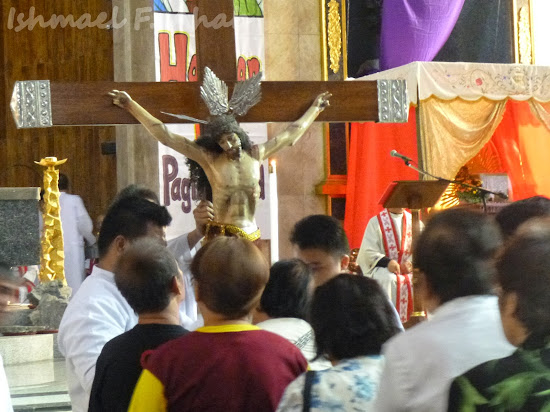Yesterday, My Beloved Wife and I went to
Santa Cruz Church for the Siete Palabras. I was appalled on our way to the church because of the crowd blocking the every path to our destination.
It was like mini-Fiesta of the Black Nazarene. Devotees walked barefoot and many of them brought their replicas of the Black Nazarene.
I suddenly remembered that it was FRIDAY, which meant it was Quiapo Day. It was also Good Friday, making it a more special day for the Black Nazarene devotees.
Quiapo Church, officially known as the Minor Basilica of the Black Nazarene, is one of the popular churches in the Philippines and the most popular church in Manila. Millions of people from different parts of the world go to Quiapo Church to join the Translacion every 9th day of January.

Quiapo Church is a memorable place for me. This is where
I brought Foong, a Malaysian friend and fellow blogger, to eat the much dreaded balut. This is where
I received kumpil or the Sacrament of Confirmation. I see Quiapo Church, almost every day, that’s why it became a part of my life.
The district of Quiapo was established in 1586 by the Governor General Santiago de Vera. The first structure of Quiapo Church, built by Franciscan missionaries, was made of bamboo and nipa and was destroyed by fire in 1639. It was replaced by a stronger structure that was partially destroyed by an earthquake in 1863.
The next structure of Quiapo Church was completed in 1899 through the efforts of Reverends Manuel Roxas and Eusebio de Leon. Sadly, Quiapo Church was again destroyed by fire in 1929.

The current structure of Quiapo Church was planned by the National Artist, Juan Nakpil. The church is colored cream white. Two belfry flank the main structure of the church. Each side of the church has statues of saints, my favorite of whom is the one holding a cross.
Many people go to Quiapo Church just to see and touch the image of the Black Nazarene. Some patiently wait the long queue for the pahalik, or kissing the image. Some visitors of Quiapo Church are just contented in touching the replica of the Black Nazarene in front of the church.
Many devotees testify that our God answered their prayers after theur prayed to the Black Nazarene. Those who are ill were healed. Those who had problems with their family, finances and faith were also solved. In fact, many of the Black Nazarene devotees are people who are giving thanks to our God because of the blessings that He gave to them.
The church’s interior is beautiful. Its ceiling and walls are not fully decorated with images and symbols. These parts of the church were simple and almost bare. What’s packed with decorations is the altar, the center of which is the image of the Black Nazarene.
The image of the Black Nazarene came from Mexico, through the Galleon trade between Manila and Acapulco. It was alleged that the image became black because of the fire on the galleon that burned the image.
Unknown to many, the image of the Black Nazarene at the altar of Quiapo Church is not wholly original. It is a combination of original head and replica body sculpted by Gener Manlaqui. The original body and replica head is the one that travels during the Translacion.
I always look up at the dome every time I visit Quiapo Church. My favourite part are the sculpted images of the four symbols of the four evangelists; namely; Matthew, Mark, Luke, and John.
I like the design of Quiapo Church’s tabernacle. The image of lamb on the top of it perfectly signifies Christ who is the lamb sacrificed for the salvation of all. Unfortunately, the tabernacle was placed at the side.

I have plenty of memories in this church and I know that more memories will be added. I do wish to join the next Translacion so I can experience what the devotees experience during that day. I do hope that my next blog post will be about that holy event.
Quiapo Church is the last church to be featured for this year’s virtual Visita Iglesia. This signals the end of our waiting because tomorrow we will commemorate the victory of our Lord against death. Jesus is ALIVE. Hallelujah!
---
Some the information that I posted here were obtained from the following:
1. Phiippine Historical Committee marker at Quiapo Church
2.
Quiapo Church and
Black Nazarene articles in Wikipedia.
3. History of Quiapo Church article in
Minor Basilica of the Black Nazarene website.
---
Visita Iglesia is a Catholic tradition of visiting seven churches during Maundy Thursday. For each day, this Holy Week, I will feature one church as a sort of virtual Visita Iglesia.
.




















































